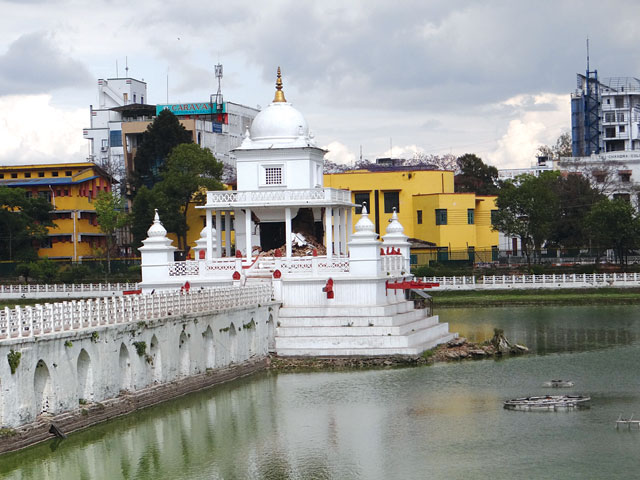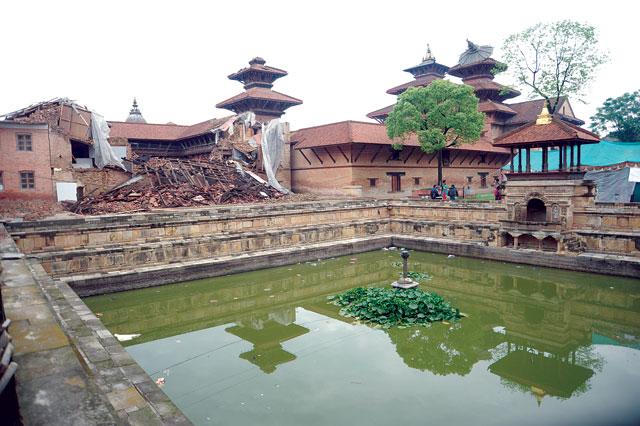Heritages are something we inherit from our ancestors, they are those monuments, traditions, objects, and cultures that have passed the test of time and crossed a 100 years. In such times of disaster through natural calamities, they become a prime concern, their preservation, conservation and restoration for benefit of the future generation.
Nepal is a land known to many. For mountaineers it is the land of Mt. Everest, for Hindus, it is the land of Pashupatinath, for Buddhists it is the land where Buddha was born. During the Hippy era, it was known as the land of Marijuana. For the earnest it is the land of the Living Goddess and for the tourist it is a land of cultural heritages.
Yes! Nepal always boasted its resplendent art, architecture, culture as well as its tangible and intangible heritages. Its art, with beautifully carved idols and minutely executed paintings are comparable to any form of art of the classical era. It introduced to the world, the unique style of temple architecture, the devala popularly known as the pagoda style. These are what we call our cultural heritages, something we inherit from our ancestors. Heritage can include traditions, monuments, objects, and culture and can also be understood as something that connects us to our past and the range of contemporary activities, meanings, and behaviors that we draw from them. They are our identity and living documentations of our past. They provide an automatic sense of unity and belonging within a group and allows us to better understand previous generations and the history of where we come from. In simple words cultural heritage is the legacy of physical artifacts and intangible attributes of a group or society that are inherited from past generations, maintained in the present and bestowed for the benefit of future generations.
Comfortably perched between the foothills of the mighty Himalayas and the Gangetic plains, Nepal enjoys a diverse topography in such a short physical distance, not found anywhere else in the world. It enjoys a pleasant climate, envious to it northern and southern neighbors. Its varied flora and fauna has been much discussed in international seminars. Although troubled and tortured by political upheavals, Nepalis seldom complain, they are a group of happy-go-lucky people, very content with what they have. However satisfied and happy its citizens remained, nature plays its games in its own ways. Nepal known famously as a tourism destination sits on top of a seismic fault line, which invites many frequent earthquakes, known to us. The recent devastating earthquake has taught us all, that quakes happen in large numbers all over the world.
 The recent earthquake of 7.6 magnitude has definitely shaken many districts of central Nepal. Not only has it shaken the people, but the very core of Nepali soil, its houses, buildings, schools, offices, institutions, multi-tower apartments, entire villages, toles and also its beautiful heritages. The tourism, economy, industry, education, agriculture of the country are all at stake and so are the cultural heritages.
The recent earthquake of 7.6 magnitude has definitely shaken many districts of central Nepal. Not only has it shaken the people, but the very core of Nepali soil, its houses, buildings, schools, offices, institutions, multi-tower apartments, entire villages, toles and also its beautiful heritages. The tourism, economy, industry, education, agriculture of the country are all at stake and so are the cultural heritages.
Such destructions could have been minimized had we followed the basic requirements set down by our ancient scriptures of Vastu-Shastra. The Samarangana Sutradhara, one of the most important books of the science of architecture, mentions a site survey and soil test as a prerequisite before the commencement of any construction.
In total, 721 monuments have been affected in 20 districts, 133 totally destroyed, 229 slightly affected and 40-50 of them are in a state of demolition as stated by Ram Kunwar, Senior Archaeologist, Department of Archaeology (DOA), Government of Nepal. At times of such natural disasters or crises, it is of prime importance to salvage the slightly damaged ones, he opines. Shoring the pillars and convexed walls, covering them with tarps to prevent water seepage from the rains, documentations and preparing an inventory are the part of the first phase of rescue. Renovation of the partially damaged and reconstruction of the totally damaged are a part of the later phase. They are our pride and identity and reflect the skill of our ancestors.
Our religious scriptures, namely the Pratistha lakshana Samuchaya mentions the replacement of damaged images and idols in a temple. It further mentions that such damaged images are abandoned by gods and become the abode of ghosts, goblins and spirits. Could these replacements raise questions of historicity and authenticity of these idols and heritages? Prakash Darnal, chief of National Archives, mentions, History, is a continuation of past events, therefore replacements should not affect the historicity. Such situations give opportunities for the organization of site museums, which are very few in Nepal. The damaged idols and architectural fragments can be displayed in a secured sattal or pati in the temple premises, he opines. We cannot discard what happens in the past, they are the substance to make history, they need to be documented and stored. And that is exactly what the DOA has done. It posted officials at most of the damaged sites to record and document and make inventories while the Armed Police Force and Nepal Army together with volunteers helped to clear the remains and parts of temple architecture and icons.
 The last earthquake we know of which caused significant damages was the one of 1934. Then too, the houses, palaces, offices, educational institutions and heritages were badly destroyed. The then Prime Minister Juddha Sumsher JB Rana, gathered all the national treasures and renovated and reconstructed many of the heritages, without any outside aid.
The last earthquake we know of which caused significant damages was the one of 1934. Then too, the houses, palaces, offices, educational institutions and heritages were badly destroyed. The then Prime Minister Juddha Sumsher JB Rana, gathered all the national treasures and renovated and reconstructed many of the heritages, without any outside aid.
Some of those renovated and restored are the Tajeju, Jagannath, Kalmochan temples and the Akhadas at Tripureswor, the Dharahara, Ghanta ghar and the Rani Pokhari temple from Kathmandu. Bhai Dega, Chasingdeo of Patan and the 55 window palace and Fasi Dega, Bhairava temple at Bhaktapur. During the process of renovation and reconstruction many temples were altered in shape , size and style and some were never repaired. Domes replaced multi tiers and many were plastered with a white wash concealing the original brick work of the Newari style of temple architecture. Such modifications are unacceptable by the present norms of conservation and restoration. But at that time there was no protection acts or UN organizations. The UNESCO was established in 1946 and the DOA in 1953. There were no acts or norms and rules set, thus what happened at that time, will have to pass as the best efforts and appreciate them.
However we now have the DOA and the UNESCO which support the protection of heritage for cultural diversity. Times of such natural disaster and damage of heritage sites may raise many questions of historicity and authenticity. In relation to this, Dr Dina Bangdel, Art historian opines that any idol or temple has many lives, as an impact of destruction through a natural calamity of theft. Idols are replaced after consecration because our traditions do not allow worship of damaged idols. Although the memory of the old one continues a new history is recorded with the replacement of the new.
As mentioned earlier, we are still in the first stage of rescuing, salvaging and conserving our damaged heritages presently and it will definitely take a while before DOA, the official authorities start the process of renovation and reconstruction. The norms of renovation does not allow for a change in material or technology to be adapted during the process of restoration. However, considering the fact that Nepal sits on top of a known fault-line, is it not time we give this clause a thought? Is it not a time to rethink about incorporating modern technology and sturdier material, while retaining the flavor and essence of the old? Scholars of Nepali history and culture, Dr Mukunda Raj Aryal, Prakash Darnal, Ram Kunwar all agree that it the right time to rethink and discuss. Such natural calamities have been frequent occurrence, knowing so restorations and renovation have been a continuous process, however as Mr Darnal mentions a routine health check up of our heritage sites is as important as routine human health checkups. This could probably strengthen them and we can be more prepared for less damages in
future calamities.









